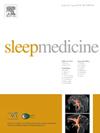睡眠特征与大脑结构:系统回顾与荟萃分析
IF 3.8
2区 医学
Q1 CLINICAL NEUROLOGY
引用次数: 0
摘要
本文章由计算机程序翻译,如有差异,请以英文原文为准。
Sleep characteristics and brain structure: A systematic review with meta-analysis
Background
As the global population ages, the prevalence of associated conditions, including neurodegeneration and dementia, will increase. Thus, reducing risk factors is crucial to prevention. Sleep contributes to brain homeostasis and repair, which, if impaired, could lead to neurodegeneration. However, the relationship between sleep characteristics, disorders, and brain morphology is poorly understood in healthy adults. Therefore, we aimed to systematically analyse the literature and clarify how sleep characteristics are associated with brain structures.
Methods
We systematically searched PUBMED, MEDLINE, ProQuest, Web of Science, and Scopus for empirical studies of healthy adults examining the associations between sleep characteristics or disorders and brain structure, adjusting for age, gender, and head size. We conducted a meta-analysis with random effects models for volumetric studies and a seed-based spatial analysis for voxel-based morphometry (VBM) studies.
Results
One hundred and five articles (60 volumetric, 45 VBM) with 106 studies reporting 108,364 participants were included. Most studies (73.1%) found sleep characteristics and disorders to be associated with predominantly lower brain volumes (cross-sectional: 51.9% of all cross-sectional; longitudinal: 45.5% of longitudinal). In VBM studies, REM sleep behaviour disorder was linked to lower grey matter volume in the right frontal gyrus (z-score = −3.617, 68 voxels, p-value = <0 0.001).
Conclusion
Sleep characteristics - poor quality, short or long sleep - and sleep disorders are predominantly associated with lower brain volumes, suggesting that inadequate sleep (short, long or poor quality) might contribute to neurodegeneration. This insight highlights the importance of monitoring, managing, and enforcing sleep health to prevent or mitigate potential neurodegenerative processes.
求助全文
通过发布文献求助,成功后即可免费获取论文全文。
去求助
来源期刊

Sleep medicine
医学-临床神经学
CiteScore
8.40
自引率
6.20%
发文量
1060
审稿时长
49 days
期刊介绍:
Sleep Medicine aims to be a journal no one involved in clinical sleep medicine can do without.
A journal primarily focussing on the human aspects of sleep, integrating the various disciplines that are involved in sleep medicine: neurology, clinical neurophysiology, internal medicine (particularly pulmonology and cardiology), psychology, psychiatry, sleep technology, pediatrics, neurosurgery, otorhinolaryngology, and dentistry.
The journal publishes the following types of articles: Reviews (also intended as a way to bridge the gap between basic sleep research and clinical relevance); Original Research Articles; Full-length articles; Brief communications; Controversies; Case reports; Letters to the Editor; Journal search and commentaries; Book reviews; Meeting announcements; Listing of relevant organisations plus web sites.
 求助内容:
求助内容: 应助结果提醒方式:
应助结果提醒方式:


